
New Hire Onboarding: Your Essential Guide
Efficient onboarding is the linchpin for fostering employee success and retention. At Optimum, we recognize the pivotal role that an effective onboarding process plays in shaping the trajectory of our team members. In this comprehensive guide, we present a New Hire Onboarding Checklist, ensuring a seamless integration process that goes beyond the basics.

1. Tailoring Welcome Packages
Before the new hire even steps through the door, crafting a tailored welcome package is a strategic move that sets the tone for a positive onboarding experience. This personalized approach includes a warm and inviting welcome letter, extending a sincere greeting and overview of what the new employee can expect.
Additionally, the welcome package encompasses a detailed exploration of your company culture. This not only familiarizes the new hire with your values, mission, and vision but also instills a sense of belonging from the outset. To ensure a swift onboarding process, essential documents are thoughtfully included, minimizing administrative hurdles and allowing the employee to swiftly immerse themselves in their new role.
2. Setting Up Workstations
Creating an inviting and efficient workspace is vital to ensure new employees feel both welcomed and well-prepared for success from their first day. Emphasizing ergonomic principles, the focus extends beyond the basics to prioritize the physical and mental well-being of team members.
- Ergonomic Chairs: Supporting a healthy and comfortable posture during work hours.
- Adjustable Desks: Allowing personalization of workspace to individual preferences and needs.
- Proper Lighting: Enhancing the work environment, minimizing eye strain, and fostering a productive atmosphere
Recognizing the significance of a well-designed workspace, this strategy aims to contribute positively to individual well-being, promoting satisfaction and success among team members.
3. Warm Welcome by Team
Recognizing the importance of a positive first impression as the cornerstone for long-term success, our approach goes beyond formalities. Emphasizing the significance of team integration, a successful strategy places a strong focus on introducing new hires to their team in a warm and inclusive manner.
This approach aims to establish connections that extend beyond professional boundaries, fostering a sense of camaraderie among team members. By prioritizing team integration, our goal is to ensure that every new employee feels not only welcomed but genuinely embraced as a crucial member of the close-knit work family.

4. Onboarding Sessions
Structured onboarding sessions play a pivotal role in our approach, providing new hires with a holistic understanding of company dynamics, industry norms, and the intricacies of their roles. Typically conducted on the first day, these sessions lay the foundation for a clear grasp of expectations.
Essential components of our onboarding sessions include:
- Mission and Values Exploration: Delving into the broader mission and values that guide our collective efforts, fostering a shared sense of purpose among team members.
- Role Overview: Offering a comprehensive overview of the employee's role, encompassing responsibilities and key performance indicators for a smooth transition into the new position.
By prioritizing these onboarding sessions, the aim is to empower new employees with the necessary knowledge and insights for success in their roles. This inclusive approach ensures clarity from the beginning and contributes to building a cohesive and aligned team, united by a common vision and purpose.
5. Role-Specific Training
In the context of role-specific training, a dedication to fostering employee development becomes evident. These training modules surpass theoretical discussions, placing emphasis on practical experiences like hands-on training, mentorship programs, and shadowing opportunities.
Key components of role-specific training include:
- Hands-On Training: Providing practical insights to help new hires understand the tangible aspects of their responsibilities.
- Mentorship Programs: Connecting new team members with experienced mentors for guidance and support during their initial phases.
- Shadowing Opportunities: Allowing observation and learning from seasoned colleagues, providing additional layers of support and understanding.
This hands-on approach not only expedites the learning curve but also cultivates confidence and competence in job functions. With mentorship programs and shadowing opportunities, the aim is to ensure that new employees receive the necessary guidance to excel in their roles, fostering a trajectory of long-term success within their professional journey.
6. Continuous Feedback Loops
Recognizing that feedback is an ongoing process, the process incorporates weekly check-ins and continuous feedback loops. This integral approach fosters an environment characterized by open communication and the rapid development of skills.
This consistent and proactive approach to feedback is designed to create an atmosphere where open communication thrives, skills are honed rapidly, and both new hires and existing team members contribute actively to the collective growth and success of the organization.
7. Employee Assistance Programs
Highlighting an ongoing commitment to employee well-being, a successful approach extends past the initial onboarding phase. A diverse array of Employee Assistance Programs (EAPs) is available to support team members, fostering a holistic approach to managing both professional and personal challenges.
Key components of the Employee Assistance Programs encompass:
- Professional Support Services: Providing resources and counseling to address work-related challenges and enhance professional well-being.
- Personal Well-being Initiatives: Offering assistance and guidance for personal challenges, promoting a balanced and healthy lifestyle.
- Mental Health Resources: Ensuring access to mental health support services, prioritizing and addressing psychological well-being.
By facilitating these Employee Assistance Programs, the objective is to cultivate a workplace culture that places a premium on the overall wellness of team members, creating an environment where individuals can thrive both professionally and personally.
8. Ongoing Learning Opportunities
Recognizing the pivotal role of continuous learning in fostering professional growth, one should integrate ongoing training and development programs. This initiative aims to empower team members with the tools and knowledge necessary to stay ahead in their respective fields.
Key components of the commitment to ongoing learning include:
- Industry-Specific Workshops: Providing access to targeted workshops to stay informed about industry trends and best practices.
- Skill Enhancement Courses Offering opportunities for skill development, contributing to enhanced proficiency and adaptability.
- Professional Development Initiatives: Cultivating a culture of continuous improvement through initiatives that support career advancement.
Through the incorporation of these ongoing learning opportunities, the objective is to cultivate a workforce capable of adapting to evolving industry landscapes and actively contributing to innovation, ensuring sustained success in their professional journey.
FAQs
What is the significance of role-specific training in the onboarding process? Role-specific training is crucial in ensuring that new hires gain practical insights into their responsibilities, fostering a quicker and more confident transition into their roles.
How often are the continuous feedback loops conducted during the onboarding period? Continuous feedback loops, including weekly check-ins, are an integral part of our onboarding process, creating an environment of open communication and facilitating rapid skill development.
What types of support are provided through the Employee Assistance Programs (EAPs) beyond onboarding? The Employee Assistance Programs offer a range of support services, including professional assistance, personal well-being initiatives, and mental health resources to promote holistic employee wellness.
How does the ongoing learning opportunities initiative contribute to employee growth Ongoing learning opportunities, such as industry-specific workshops and skill enhancement courses, empower team members to stay ahead in their fields, fostering adaptability and contributing to their professional development.
Conclusion
The commitment to prioritizing personalization, providing thorough training, and continuous support ensures that every individual not only joins but thrives in their respective work environments. As you embark on this onboarding journey, anticipate more than a checklist – envision a transformative and enriching onboarding experience that lays the foundation for long-term professional success.
Contact us and learn how Optimum Employee Onboarding can streamline your onboarding workflows.